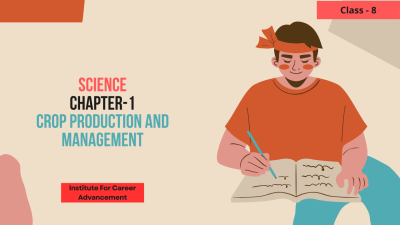| Expiry period |
Lifetime |
|
|
| Made in |
English |
|
|
| Last updated at |
Wed Nov 2024 |
|
|
| Level |
Beginner |
|
|
| Total lectures |
0 |
|
|
| Total quizzes |
0 |
|
|
| Total duration |
Hours |
|
|
| Total enrolment |
 0
0 |
|
|
| Number of reviews |
0 |
|
|
| Avg rating |
|
|
|
| Short description |
Crops are plants that are produced and harvested by farmers for profit or subsistence. Crops may be ingested by both animals and humans and are necessary for life to exist. Agriculture is the branch of science that deals with the study of agricultural cultivation and cattle rearing. Crops can be cultivated in two ways: agriculture or aquaculture. Crops are harvested and utilised as food for humans or fodder for livestock.
Crops are plants that are grown on a big scale from the same variety. Crops are classified according to the seasons in which they grow:
Kharif Crops -These crops are planted in the early monsoon season, which varies depending on the crop and region of agriculture. Kharif crops are planted in India between June and July, at the start of the rainy season. These crops are harvested near the conclusion of the monsoon season, between September and October. The principal Kharif crop is paddy.
Rabi Crops – These crops are sown throughout the winter and following the monsoon season, which occurs between October and November. Rabi crops are harvested in India during the spring months of March and April. Wheat is the most important Rabi crop.
ফসল হল এমন উদ্ভিদ যা কৃষকদের দ্বারা লাভ বা জীবিকা নির্বাহের জন্য উৎপাদিত ও সংগ্রহ করা হয়। প্রাণী এবং মানুষ উভয়ের দ্বারা শস্য গ্রহণ করা যেতে পারে এবং জীবনের অস্তিত্বের জন্য প্রয়োজনীয়। কৃষি হল বিজ্ঞানের একটি শাখা যা কৃষি চাষ এবং গবাদি পশু পালনের অধ্যয়নের সাথে সম্পর্কিত। ফসল দুটি উপায়ে চাষ করা যেতে পারে: কৃষি বা জলজ চাষ। শস্য সংগ্রহ করা হয় এবং মানুষের জন্য খাদ্য বা গবাদি পশুর জন্য খাদ্য হিসাবে ব্যবহার করা হয়।
শস্য হল উদ্ভিদ যা একই জাত থেকে বড় আকারে জন্মায়। ফসলগুলি যে ঋতুতে জন্মায় সে অনুসারে শ্রেণীবদ্ধ করা হয়:
খরিফ ফসল - এই ফসলগুলি বর্ষার প্রথম দিকে রোপণ করা হয়, যা ফসল এবং কৃষি অঞ্চলের উপর নির্ভর করে পরিবর্তিত হয়। ভারতে খরিফ ফসল রোপণ করা হয় জুন থেকে জুলাই মাসের মধ্যে, বর্ষার শুরুতে। এই ফসলগুলি বর্ষা মৌসুমের শেষের কাছাকাছি, সেপ্টেম্বর থেকে অক্টোবরের মধ্যে কাটা হয়। প্রধান খরিফ ফসল হল ধান।
রবি শস্য - এই ফসলগুলি সারা শীত জুড়ে বপন করা হয় এবং বর্ষা মৌসুমের পরে, যা অক্টোবর থেকে নভেম্বরের মধ্যে ঘটে। ভারতে মার্চ ও এপ্রিলের বসন্ত মাসে রবি ফসল কাটা হয়। গম সবচেয়ে গুরুত্বপূর্ণ রবি শস্য। |
|
|
| Outcomes |
- Here are the key outcomes: Knowledge and Understanding: Basic Agricultural Concepts: Students should grasp fundamental concepts such as soil types, climatic factors affecting crop growth, and the role of nutrients in plant development. Crop Selection and Management: Understand the criteria for selecting suitable crops based on climate and soil conditions. Learn about crop rotation, intercropping, and their benefits. Soil Preparation and Fertilization: Gain knowledge of methods for soil preparation, such as ploughing and levelling, and learn the importance of adding manures and fertilizers to improve soil fertility. Pest and Disease Management: Identify common pests, weeds, and diseases affecting crops. Learn about different control methods, including biological, chemical, and cultural approaches. Harvesting and Storage: Understand techniques for harvesting different crops and the importance of proper storage to maintain quality and prevent post-harvest losses.
- এখানে মূল ফলাফল আছে: জ্ঞান এবং বোঝা: মৌলিক কৃষি ধারণা: শিক্ষার্থীদের মৌলিক ধারণা যেমন মাটির ধরন, ফসলের বৃদ্ধিকে প্রভাবিত করে এমন জলবায়ু বিষয়ক এবং উদ্ভিদের বিকাশে পুষ্টির ভূমিকার মতো বিষয়গুলোকে উপলব্ধি করতে হবে। শস্য নির্বাচন এবং ব্যবস্থাপনা: জলবায়ু এবং মাটির অবস্থার উপর ভিত্তি করে উপযুক্ত ফসল নির্বাচনের মানদণ্ড বুঝুন। ফসলের ঘূর্ণন, আন্তঃফসল, এবং তাদের উপকারিতা সম্পর্কে জানুন। মাটি প্রস্তুতি এবং নিষিক্তকরণ: মাটি তৈরির পদ্ধতি সম্পর্কে জ্ঞান অর্জন করুন, যেমন লাঙ্গল এবং সমতলকরণ, এবং মাটির উর্বরতা উন্নত করতে সার ও সার যোগ করার গুরুত্ব জানুন। কীটপতঙ্গ ও রোগ ব্যবস্থাপনা: সাধারণ কীটপতঙ্গ, আগাছা এবং ফসলকে প্রভাবিত করে এমন রোগ চিহ্নিত করুন। জৈবিক, রাসায়নিক এবং সাংস্কৃতিক পদ্ধতি সহ বিভিন্ন নিয়ন্ত্রণ পদ্ধতি সম্পর্কে জানুন। ফসল সংগ্রহ এবং সংরক্ষণ: বিভিন্ন ফসল সংগ্রহের কৌশল এবং গুণমান বজায় রাখতে এবং ফসল-পরবর্তী ক্ষতি রোধ করার জন্য সঠিক স্টোরেজের গুরুত্ব বুঝুন।
|
|
|
| Requirements |
- Agriculture can have significant environmental impacts. Studying crop production and management helps in adopting practices that minimize negative environmental effects, such as soil erosion, water pollution, and deforestation. Agriculture is often the backbone of rural economies. Knowledge of crop production and management supports rural development by improving agricultural productivity, income generation, and living standards. Studying crop production and management opens up career opportunities in agriculture-related fields such as agronomy, agricultural engineering, agricultural economics, research, and development.
- কৃষিতে উল্লেখযোগ্য পরিবেশগত প্রভাব থাকতে পারে। শস্য উৎপাদন ও ব্যবস্থাপনা অধ্যয়ন অভ্যাস গ্রহণ করতে সাহায্য করে যা নেতিবাচক পরিবেশগত প্রভাব যেমন মাটির ক্ষয়, জল দূষণ এবং বন উজাড় কমিয়ে দেয়। কৃষি প্রায়শই গ্রামীণ অর্থনীতির মেরুদণ্ড। ফসল উৎপাদন ও ব্যবস্থাপনার জ্ঞান কৃষি উৎপাদনশীলতা, আয় বৃদ্ধি এবং জীবনযাত্রার মান উন্নত করে গ্রামীণ উন্নয়নে সহায়তা করে। শস্য উৎপাদন ও ব্যবস্থাপনা অধ্যয়ন কৃষি-সম্পর্কিত ক্ষেত্রে যেমন কৃষিবিদ্যা, কৃষি প্রকৌশল, কৃষি অর্থনীতি, গবেষণা এবং উন্নয়নে কর্মজীবনের সুযোগ উন্মুক্ত করে।
|
|
|


 0
0 